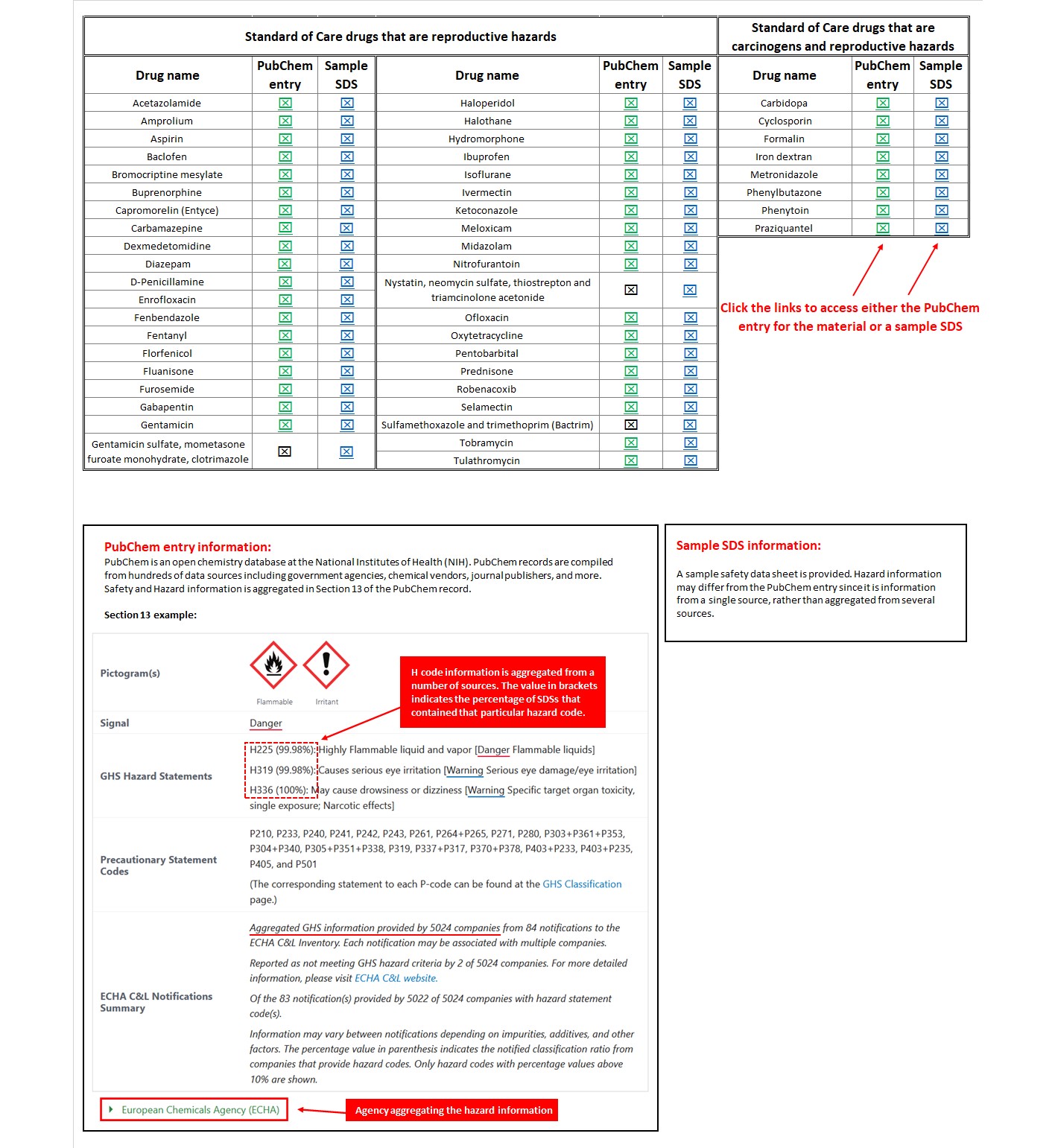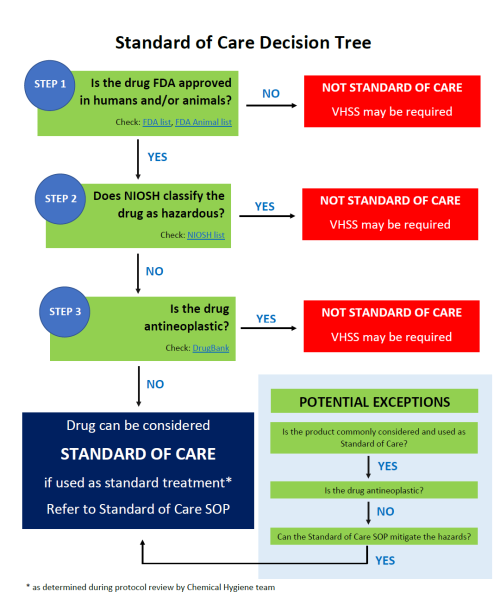Information for Animal Care Staff, Facility Managers/Technicians-In-Charge
- Roles & Responsibilities for Facility Managers and Technicians-In-Charge
-
Facility managers/Technicians-in-charge are responsible for the following (summarized from Policy 49):
1. Establish a method for PIs/researchers to alert vivarium staff that a hazardous material or Standard of Care medication is present (e.g., hazard cards, door signs). Provide training to the PI and research personnel regarding vivarium hazard notification and ensure compliance with the established Facility-defined. 2. Provide training for PIs/researchers as needed, including, but not limited to, approved areas for animal dosing, procedures for vivarium waste disposal, hazardous material storage (if applicable), and protocols for handling soiled vivarium-owned (PPE). 3. Implement the Hazard Communication Program as part of the Injury and Illness Prevention Program (IIPP), including training on how to access and interpret Safety Data Sheets and responsibilities to fulfill the training described in PPM 290-27, including spill response. 4. Ensure that the necessary hazard communication signage is in place, animal care staff are notified and trained on hazardous material handling, PPE is available, and any special husbandry requirements for studies involving hazardous materials (e.g., bedding disposal) are in place. 5. Ensure staff are aware they have access to Table 14b which lists all materials proposed for use in the ACUP. These include non-hazardous and Standard of Care medications. 6. Ensure staff have access to Table 8, which lists all hazardous materials, as well as materials with specific handling requirements. 7. Ensure access to, and training on, the Standard of Care medications list. 8. Train staff on how to read a Vivarium Hazard Safety Sheet (VHSS) and Safety Data Sheets (SDSs). - Roles & Responsibilities for Animal Care Staff, Research Staff, Student Interns, and Support Personnel
- Animal Care Staff, Research Staff, Student Interns, and Support Personnel are responsible for the following (summarized from Policy 49):
1. Follow VHSS, ACUP, and all other safety procedures while handling hazardous animals, soiled PPE, or by-products. 2. Wear required PPE at all times. 3. Know the process for reviewing and researching substances in Section 14 of the ACUP that may not be included in Section 8 of the ACUP. Know where to find hazard information, including SDSs. 4. Alert their Supervisor, Facility Manager, or Technician-in-Charge if they have not received training on a substance, if appropriate signage (door or cage card) is not present, if a substance is not being administered in the manner outlined, or if there is a breach in containment of a hazard. 5. Respond when there is a chemical spill or wrongful, unsafe disposal of possible hazardous material using the methods outlined in their initial training. 6. Alert any personnel who enter a space where hazards are present to don proper PPE. - Hazard Communication Program
- All animal care spaces at UC Davis fall under the Hazard Communication Program. This program is designed to increase employee awareness of any chemicals and/or medications used in the workplace by providing information about these materials, identifying the associated hazards and potential harmful effects, and how to protect from the risks of those hazards. The Hazard Communication Program must clarify standard PPE practices and animal handling requirements to protect workers from Standard of Care medications, procedures to protect workers from exposure to hazardous materials, as well as the facility determined method for PIs/researchers to alert vivarium staff that a hazardous material or Standard of Care medication is present (e.g., hazard cards, door signs).
Read more about the Hazard Communication Program. - Training Requirements
- Animal care staff should complete the following training pertaining to hazard communication before beginning work in an animal care space. Additional animal care training may be required.
1. Complete Hazard Communication Training prior to starting work in the vivarium. 2. Review and complete training on the Facility-specific Hazard Communication Program with the Facility Manager/Technician-in-Charge. 3. Be familiar with the location of the Standard of Care list, as well as any hazards associated with these materials. 4. Be familiar with the location and content of any applicable Safety Data Sheets (SDSs) for the Standard of Care medications that may be used in the Facility. 5. Know how to read and interpret a Vivarium Hazard Safety Sheet (VHSS). 6. Review applicable policies including IACUC Policy 38, IACUC Policy 49, and Animal Care Program Personal Protective Equipment Policy (SC-10-102). - How to Read and Access Safety Data Sheets (SDSs)
-
Safety Data Sheets (SDSs) are a primary source of information regarding chemical hazards and handling. Understanding how to access, read, and interpret the information presented in an SDS is important to safely handling hazardous materials.
Check out our guide to reading and interpreting SDSs.
Accessing Safety Data Sheets
SDSs can be accessed a variety of ways. The first method is to search for the product specific SDS on the manufacturers website. SDSs can also be accessed through a variety of Chemical Safety Databases, including:
University of California SDS Search (RSS Safety Suite login required)
SDS Search
Many manufacturers also have SDS databases available, including:
Alfa Aesar
Bio-Rad (click "Literature Library" for access)
Millipore-Sigma
The Safety Services SDS webpage lists a number of additional databases, as well as more vendor resources, for accessing SDSs.
Additional resources:
OSHA: How to read a Safety Data Sheet - Standard of Care Medication Definition and Decision Tree
-
Standard of care medications are those that are FDA approved for use in humans and/or animals, AND that do NOT appear on the NIOSH “List of Hazardous Drugs in Healthcare Settings”. These medications do not require a VHSS whether being used clinically or as part of an approved IACUC protocol. This condition holds true only if the medications are administered in a veterinary formulary approved route and appropriate dose for the application: any medications administered outside of an approved route will be subject to chemical safety office review and may require a VHSS.
When administered, Standard of Care medications must be declared using the method outlined by the Facility.
Note: if a Standard of Care medication has a known hazard that is not mitigated by standard PPE and engineering controls for that facility, or if it is being used experimentally rather than clinically and has a known hazard, it will be included in Section 8 of the protocol and will receive a VHSS. - Standard of Care Medication Standard Operating Procedure (SOP)
- A Standard of Care Standard Operating Procedure (SOP) is available. This SOP can be used to outline in greater detail the Facility-specific controls and PPE that must be used in the animal facility.
- Full List of Approved Standard of Care Medications with SDSs
-
Some Standard of Care medications are known to have health hazards: although mitigated by the standard PPE and engineering controls for the facility when used clinically, it is still important to recognize that the hazard does exist. Below are two lists indicating which Standard of Care drugs have reproductive hazards, and which have both reproductive hazards and are carcinogens.
Standard of Care medications are drugs that are given clinically such as analgesics, antibiotics, anesthetics, and clinical/standard treatments. The full Standard of Care list can be found here. 
- How to Read a Vivarium Hazard Safety Sheet (VHSS)
-
There are three types of VHSS: chemical, biological, and radiochemical. Check out our training on how to read and interpret these 3 types of VHSS.
Viviarum Hazard Safety Sheets (VHSSs) serve as a tool to inform animal care staff of specific hazards and to inform of proper administrative and engineering controls, PPE, and waste disposal requirements. A VHSS is created for protocols where animals will be administered hazardous chemicals, recombinant/biohazardous material, and radioactive material, as well as for environmental hazards or materials with non-routine disposal requirements to ensure proper handling. - Hazardous Waste – as it pertains to cages and bedding
- Bedding/Caging are no longer considered hazardous when the bedding is changed after the time frame indicated on the VHSS. Note that the hazard remains in the bedding until the VHSS timeframe has passed AND the bedding has been changed. Waste label requirements for disposal of contaminated items can be found on the VHSS.
All cage dumping must occur using the methods outlined in the VHSS.
